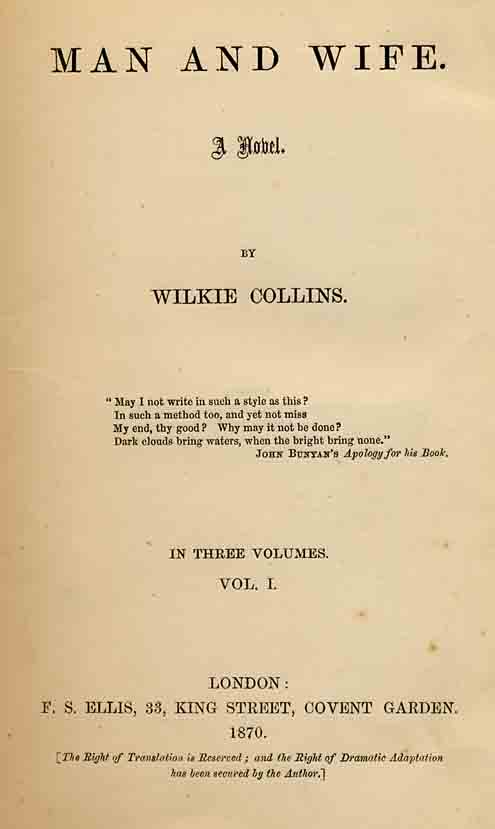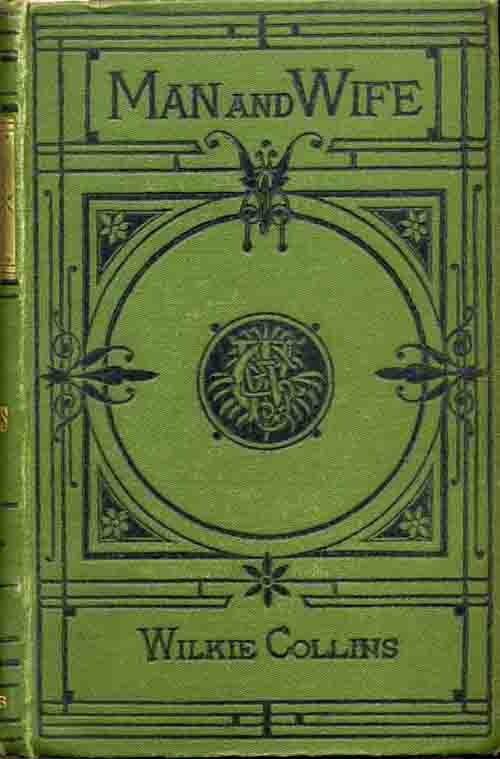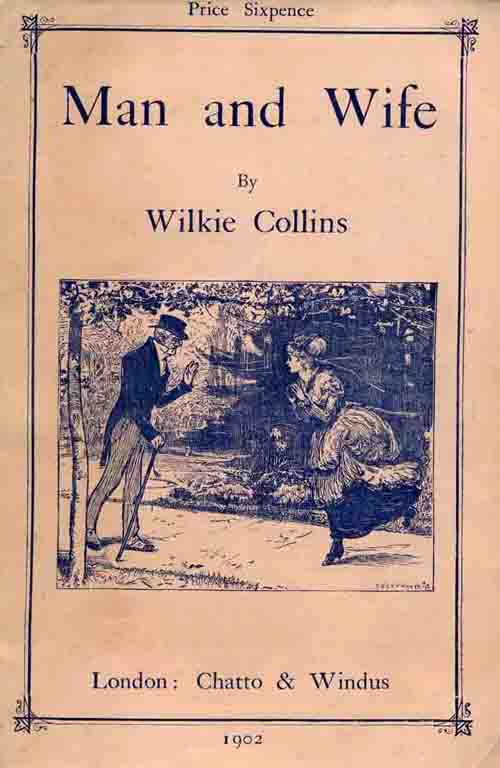'It is the nature of Truth to struggle to the light'
[
Plot
Summary ] [ Publishing History ] [ Dramatic
Version ]

1870 first edition title-page by F. S. Ellis
Novel published in 1870, dedicated to Frederick and Nina Lehmann with whom Collins stayed during much of its composition. Their surname, thinly disguised, and their musical abilities on the violin and piano appear in the characters of Julius Delamayn and his wife. Often cited as Collins's first didactic work, Man and Wife attacks both Irish and Scottish marriage laws as well as arguing the case for a Married Woman's Property Act. The book also campaigns against the cult of athleticism, as leading to moral and physical corruption, personified in the villain, Geoffrey Delamayn. Contemporary reviewers generally praised the excitement and cleverness of the plot but did not appreciate Collins's higher motives. The Saturday Review (9 July 1870) considered 'If one moral is generally too much, two morals are surely unjustifiable. Mr Collins might be content with assaulting running and boat-racing without breaking a lance at the same moment against all our marriage laws'. The story of Hester Dethridge, as well as strengthening the novel's attack on the marriage laws by illustrating the helplessness of working-class married women, also represents a contribution by Collins to the detective genre by creating an early example of a 'locked-room' murder. The story was originally conceived as a play and the book is divided into fifteen Scenes.
|
|
|
| 1871 Smith, Elder first one volume edition | 1875 Chatto & Windus Piccadilly Novels |

From the 1875 Chatto & Windus Piccadilly Novels
In 1855, a clever young lawyer called Delamayn finds a loophole in the
Irish marriage laws which enables John Vanborough to annul the marriage that
stands in the way of his parliamentary ambitions.
The abandoned wife, Anne Silvester, lives with her old friend, Blanche,
married to Sir Thomas Lundie, together with their respective daughters, also
called Anne and Blanche.
Twelve years later Vanborough, and Anne and Blanche senior are all dead.
Sir Thomas has remarried but dies shortly after, when the title and
estate pass to his likeable brother, Sir Patrick Lundie, a retired lawyer in
his seventies. Sir Thomas is
survived by his second wife, the overbearing Lady Lundie, now responsible for
the two daughters. The lawyer,
Delamayn, has succeeded in life and become Lord Holchester with two sons,
Geoffrey and Julius.
The main action of the story begins in 1868 at Windygates, the Perthshire
home of Lady Lundie. Blanche is
now 18 and Anne, acting as her governess, 25.
Visiting them are Sir Patrick; Arnold Brinkworth, engaged to Blanche;
and Geoffrey Delamayn, the school friend who once saved Arnold's life.
Geoffrey has promised to marry Anne but is now trying to break the
secret engagement because he will be cut out of his father's will.
Anne persuades him to accept a secret marriage and knowing a little of
the Scottish law arranges to go to a lonely inn at Craig Fernie where she will
announce that she is waiting for her husband.
If Geoffrey arrives and openly asks for his wife, the presence of
witnesses will validate the marriage according to Scottish law.
Geoffrey receives a telegram that his father is dangerously ill and must
go to London with his brother. He
therefore asks Arnold to deliver a message to Anne at the inn, carefully
telling him not to use his own name but merely to ask for his 'wife'.
Arnold reluctantly agrees but makes Geoffrey put the message in
writing. The note, stating
Geoffrey's intention to marry, is written on the back of a letter from Anne
signed 'your loving wife'. Arnold
arrives at Craig Fernie and to preserve Anne's reputation pretends to be her
husband in front of the Landlady and the head waiter, Bishopriggs.
Anne reads the letter which is subsequently stolen by Bishopsriggs
while Arnold innocently continues the deception, sleeping on the sofa and
leaving early the next morning.
Lord Holchester recovers but on his sick-bed remembers he was responsible
for the infamous treatment of Anne's mother and asks Julius to help her if she
should ever need assistance. At
the same time Lord Holchester will only accept Geoffrey back into the family
if he makes a respectable marriage. Julius
and his mother have in mind the young widow, Mrs Glenarm, whom Geoffrey will
meet on his return to Scotland.
Anne is worried about her marital status and without disclosing Arnold's
name, has Blanche consult Sir Patrick. Geoffrey
overhears the opinion that the marriage is ambiguous, but that two people are
legally bound in Scotland if they pretend to be married.
He therefore adopts the view that Anne is technically married to Arnold
and he is free to marry Mrs Glenarm. By
this time Geoffrey has agreed to represent the South in the great foot-race, a
national athletic event against the North, although a medical guest in the
house, Mr Speedwell, warns that the exertion would endanger his health.
Anne visits Blanche at Windygates and meets Geoffrey who declares he
cannot now marry her as she is already married to Arnold.
In a state of shock, she deliberately leaves her friends and hides in
Glasgow where she consults two different lawyers.
They give conflicting opinions as to whether she is married and she
collapses under the strain with a miscarriage.
Ignorant of Anne and Arnold's position, Sir Patrick brings forward
Blanche's wedding to Arnold. The
couple are recalled from their honeymoon in Switzerland when Sir Patrick hears
from Anne, who reveals Arnold's predicament and the conflicting legal
opinions. Anne meanwhile recovers
the stolen letter from Bishopriggs and tries to convince Mrs Glenarm of
Geoffrey's prior marriage. Lady
Lundie deduces that Arnold was the man at Craig Fernie and mischievously
persuades Blanche to leave Arnold for her house in London where Mrs Glenarm is
also staying. Sir Patrick must
prove the Craig Fernie marriage is invalid to safeguard Arnold's position with
Blanche, whereas Mrs Glenarm wants it confirmed so that Geoffrey is free to
marry her.
Geoffrey has rented a secluded house in Fulham, left to Lady Lundie's
former cook Hester Dethridge, an elderly woman who is mute after a traumatic
marriage to a drunken husband and communicates only in writing.
Against medical advice Geoffrey completes his intensive training for
the foot-race. On the last lap of
the four-mile course he collapses, unable to continue.
He is abandoned by his friends because they lost money on the race and
is taken home by his trainer, Perry
Two days after the race, all parties attend a family conference with
their lawyers. Geoffrey refuses to
accept Anne as his wife and Blanche will not return to Arnold until the
ambiguity of the Craig Fernie marriage is resolved.
Anne, despite knowing she will have to return to Fulham, bravely
produces her letter which according to the Scottish law of consent confirms
her marriage to Geoffrey.
Following the death of Lord Holchester, Julius has inherited the family
title and visits Geoffrey to proposes a separation.
In return Julius will honour an unsigned codicil to their father's
will, leaving Geoffrey a secure income. Geoffrey,
however, having no grounds for divorce, intends to kill his wife.
Pretending he will be a good husband he refuses his brother's offer and
keeps Anne prisoner in the house.
Geoffrey has always been unnerved by the silent and withdrawn Hester
Dethridge. The secret of her own terror of him is revealed in a written
confession of murder. Years
before, when she complained to the police that her husband ill-treated her and
stole her money, they were unable to help because the law gave a married woman
no right to her own earnings. She
determined to kill him as the only way to end her misery.
While her husband lay in a drunken stupor, she suffocated him through
the partition wall of his locked bedroom after carefully removing and
replacing the lathe and plaster. Hester
was not suspected of the crime but now sees visions of a second self urging
her to kill again.
Geoffrey blackmails Hester into helping him murder Anne by the same means
but at the last moment she sees the apparition again and attacks Geoffrey.
In the same instant he suffers a fatal stroke.
Hester is confined in an asylum while Anne, free of Geoffrey at last,
supplants Lady Lundie by marrying Sir Patrick and becoming the new female head
of the family.
|
|
|
| First US edition by Harper's in 1870 | Chatto & Windus edition in paper wrappers |
Cassell's Magazine, 20 November 1869--30 July 1870; Harper's Weekly, 11 December 1869--6 August 1870.
First English edition
3 volumes, F. S. Ellis, 1870. Dark
red cloth, covers blocked in blind, spines lettered in gilt, black or dark
green end-papers. Half-title in
each volume. Published in June
1870.
Vol I
xiv + 356 pp. 8 pp
publishers' advertisements bound in at
end
Vol II
vi + 360 pp
Vol III
vi + 348 pp
Second and third editions, 3 volumes, 1870.
1 Volume editions
Smith Elder 1871 (with a new preface noting a change in the law); Chatto
& Windus 1875-1932 (with 12 illustrations by W. Small); Dover 1983; Sutton,
Stroud 1990; World's Classics 1995 (Critical edition, edited by N. Page).
1st US edition
Harpers, New York 1870.
Translations
Dutch, The Hague (Belinfante Brothers) 1870; Russian, St Petersburg 1870;
French, Paris (by C. Bernard-Derosne), 2 vols, 1872; German, Leipzig 1872;
Italian, Milan, 2 vols 1877.
Despite the disagreement with Collins over the second edition of The Moonstone, Tinsley tried to negotiate for Man and Wife. In the end they were unable to agree terms and the book was published by F. S. Ellis on ten per cent commission although Collins frequently expressed doubts about Ellis's abilities. Sadleir suggests that the current scarcity of the title is because Ellis was 'ill-equipped to distribute a commercial product like a three volume novel.' Nevertheless the first edition of 1,000 copies sold well and a corrected second edition of 500 appeared by the end of June. A third edition, also of 500, was printed in July but at least part of this was remaindered in April 1875.
[ Top of Page ] [ Main Works ] [ Front Page ] [ Dramatic Version ]



